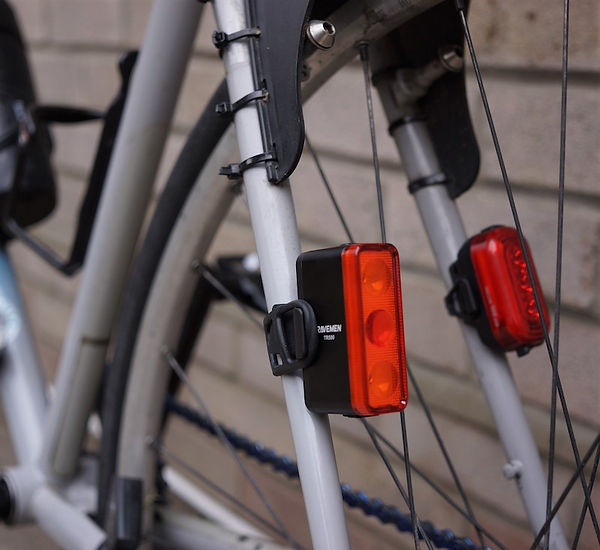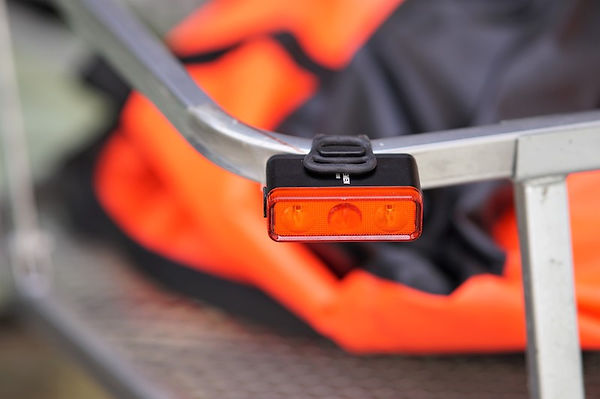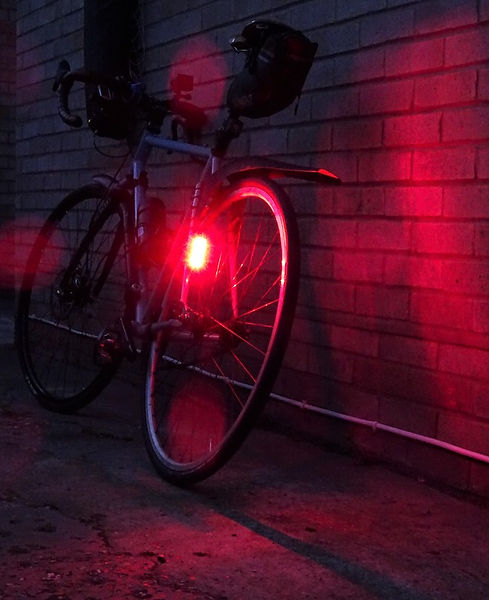
THIS SITE USES GOOGLE ANALYTICS TO ANALYSE TRAFFIC. CONTINUING TO USE THIS SITE MEANS YOU ACCEPT THE USE OF COOKIES.WE DO NOT COLLECT PERSONAL DATA LEARN MORE OR SEE OUR PRIVACY POLICY
SEVEN DAY CYCLIST
CYCLING, BUT NOT USUALLY RACING
LATEST UPDATE NOVEMBER 18th 2025
HOW DO WE REACH THE OVERALL RATINGS FOR PRODUCTS WE REVIEW?
Ravemen TR500 Rear Light
(500 Lumens) 93.5g £64.99
The Ravemen TR500 USB Rechargeable Rear Light (500 Lumens) is as the name implies, a rear light capable of delivering 500 lumens. There are six modes, braking and auto stop/start functions. On paper, it’s too potent for the concrete jungle but in practice, the lower modes are practical, especially on a cargo bike, trailer, or tagalong. Run times are also surprisingly frugal, although a full charge requires 4.5 hours.
Pros: Bright, tuneable light
Sensible modes
Solid build quality
Large surface area
User friendly
USB C Charging
Cons: Braking function can put a dent in run times
Relatively heavy
Long charge times

Materials/Specification
Measuring 41x33x62mm, the TR500 is a sizeable beast, and the large surface area lends itself nicely to trailers, tagalongs and other contexts, without looking too bulky on a more traditional solo. The body is made from anodised aluminium alloy, which is not only rugged and pretty, but also serves as a heat-sink, giving diodes, battery and circuitry a sporting chance of living long and productive lives.
Talking of which, Ravemen say it will withstand accidental drops from 1 metre Reassuring, but not something I’ve put to the test- oh, and there’s a two-year warrantee. IPX4 won’t set pulses racing and at its most literal means waterproof in the splash-proof sense. Heavy rain but not submersion in a puddle, or deeper. The port cover fits snugly, and I’ve not felt the need to add a slither of silicone grease.

The polycarbonate lens employs convex technology at the middle diode, for optimal impact, the others don’t. Reflective side strips also amplify peripheral light bleed. Diodes-wise, we have three XP-EZ red diodes, which are powered by a 1600mAh/3.7V lithium-Ion battery.
A big cell is necessary to provide the braking function and practical run times generally, which the TR500 delivers. However, even with the USB C charger, this means 4.5hours supping from a laptop/similar device. Oh, and ensure you charge to 50% every three months-if the light’s gone into seasonal/long term storage.
Switch & Modes 3.75/5
The switch is a relatively small, raised top mounted affair but surprisingly easy to locate in the dark, wearing full-finger gloves. Discounting the “braking” function and auto stop/start, there are six modes. Three constant- high (100 lumens), mid (50 lumens) and low (25 lumens); three flashing. Warning flash (500lumens) is best thought of as a daylight running mode.
Even by my standards, this kind of fire power sounds decidedly anti-social but more about that later. Rapid and slow flash complete the line-up and are 100lumens apiece. Powering up and down is just a matter of depressing the switch for half a second. Once on, a single press cruises through the modes. Engaging the braking and stop/start functions is a matter of depressing the switch (with the light off) until the light blinks rapidly- let go and you’re set. Repeat the process to disengage. Engaged, the light will automatically switch off after two minutes stationary and re-engage when it senses movement.
Braking Function
The braking function is 200lumens and like others, kicks in when it registers decreasing speed and indeed, lumpy surfaces. Unlike car and motorcycle brake lights, which employ a physical connection with other components, resulting in the light’s engagement, those integrated within bicycle lights are closer to accelerometers. The sensor(s) calculate when they believe the bicycle is slowing and trigger the more intense “braking” light for 2 seconds or so.
Obviously, this will have an impact upon run times, say if you’re tackling stop start traffic in a relatively hilly area but on the flip side (for me at least), encourages a consistent average speed during training rides.
Talking of which, the battery/charge indicator will flash when charging and reserves are dwindling. In the latter context, it will automatically kick down and disengage to a 5 lumen “eco” mode, reducing the likelihood of being plunged into darkness.
However, in the interests of getting the absolute best from batteries, avoid complete discharge wherever possible. Talking of which, while it requires a definite prod and accidental engagement hasn’t been a problem, I had ours switch on, when bouncing around in a compact bar bag.
Mount 3.75/5
A big, beefy light merits a suitably stout mount and Ravemen haven’t cut any corners. There are two shims-one for aero posts (which also allows secure fitting to seat stays and box section tubing, such as that found on my low-slung touring trailer).
There are also two lengths of straps, catering for different diameters.

No issues with posts between 25.4 and 31.8. Diameter aside, and less of an issue with modern, compact geometry framesets but ensure you’ve at least 8cm free. I’d swerve pencil thin seat stays, but my fixed gear winter/trainer proved fine-as the photos illustrate. A bit of “bodge box” experimentation confirmed my suspicions that others-including the “doughnut” type, will also work, should you be unlucky enough to lose those supplied. In a pinch, the TR500 will tether to some, beefier luggage straps but a last resort in my book.

Output/ Run Times 4.25/5
Impressive across the board, although the phrase “with great power, comes great responsibility” springs to mind, at least when it comes to flashing. The constant modes are arguably the most sensible for town and group riding-contexts where you don’t want to be scorching people’s retinas or raising their blood pressure.
The low is best. Around town, friendly acquaintances reckoned they could spot me at 200 metres and while in my view lacking the punch of a flashing mode of similar power, peripheral punch was good, so there shouldn’t be any issues with stealth when tackling roundabouts, turning right etc. The exception to this rule concerns tagalongs and trailers-I've gone for the 50-lumen steady, the 100lumen fast flash when mist has greatly reduced visibility.

Staying with the 100 lumen flashings, by my reckoning they are adequate for daylight running too. Anecdotally, other traffic picked me out at least 100 metres. Pre-dawn blasts are very much my thing. A curious farmer and a lone trucker both reckoned they clocked me at 500 metres.
This dipped to 300 with the steady counterpart but predictably the braking function bolstered that by 50-100 metres (mist and clear skies respectively). The 500 mode is mighty and even in intense sunlight, approaching riders reckoned they could pick it out at 600 metres. No excuse for a SMIDSY and great for deterring wheel sucking but anti-social at close quarters! Run times sans brake light have been within a few minutes of those cited and reassuringly reliable. When reserves really tumbled and the unit kicked down to the 5-lumen bailout, it was sufficient to limp home on, but I felt a little too inconspicuous for my tastes.
Braking functions have come along quite a bit in the past few years, but they’re still not an exact science. The 200lumen braking function engages for two seconds when it detects a drop in pace and vibration. Output is potent, without being aggressive. On average, considering factors such as gradients, traffic and rider fatigue into account, bargain on knocking 15% from the run times. Thankfully, these are very generous, so not overly problematic, but something to consider, say if you’re a kitchen sink tourist, or recumbent rider tackling big hills.
Durability/Care 3.75/5
As I said in my opening paragraph, the TR500 feels very solid and despite the IPX4 rating, it's never missed a beat in heavy rain and passed my garden hose test with flying colours. Charge regularly and avoid habitually running it low, no reason to think the TR500 won’t last a long time.
Value 3.25/5
There’s no doubt you’re getting a lot of light but £64 is also quite spendy. If you can forgo the braking function, Cat Eye Viz 450 is a four-mode model produces a maximum of 450 lumens (daylight running setting) 130 lumen group ride mode and gives change from £50.
Knog Cobber Big (£78.99) is another big model, well suited to trailers and similar contexts. It can be programmed via their app and is certainly very bright but doesn’t feature a braking function and is £14 dearer. Staying with the Cobber a minute, I remain impressed by its smaller sibling , which arguably provide all the power you’d need and is a good bit lighter than the TR500 but again, lacks the braking and daylight running function and outright punch. At £60, the Cobber Mid is only a few quid cheaper, too.
Magicshine SeeMee200 weighs in at £33.99 and is a compact cube model, pumping out a maximum of 200 lumens. It also has a tracer light, a braking function and an intelligent mode which allows the light’s sensors to determine output. It meets IPX6 for weather proofing and is certainly very bright. That said; having run one for a while, I found the brake light a little too sensitive, denting run times and that’s the only mode offering 200lumens.
Summary
The Ravemen TR500 is a lot more useable than size and output might suggest. There’s plenty of scope for suburban contexts, particularly in the lower, constant modes. The “braking” function is also highly effective, and I’m assured, captivating without destroying retinas, or fraying tempers at close quarters. The jury’s out as to whether the 500-lumen day flash is overkill although I’m fond of it and I’ve not had any negative feedback from other road users.
Dimensions, outputs and generous run times lend it to long rides along unlit roads-especially towing a trailer, or tagalong. Arguably there are lighter, dare I say, cheaper options for solos that seldom stray far from the suburbs, or pared to the essentials’ road builds. Ravemen CLO6 Rechargeable Lightweight Sensored Rear Light delivers 50 lumens, might be a better choice in these contexts-especially if you wanted a braking function.
Verdict: 4/5 Powerful yet practical light, particularly suited to trailers and specialist builds.
Michael Stenning
PUBLISHED NOVEMBER 2022





